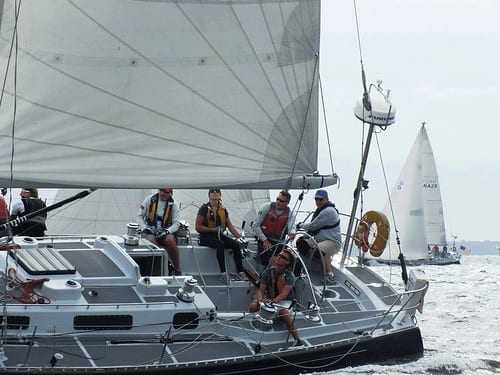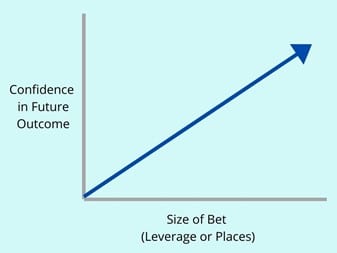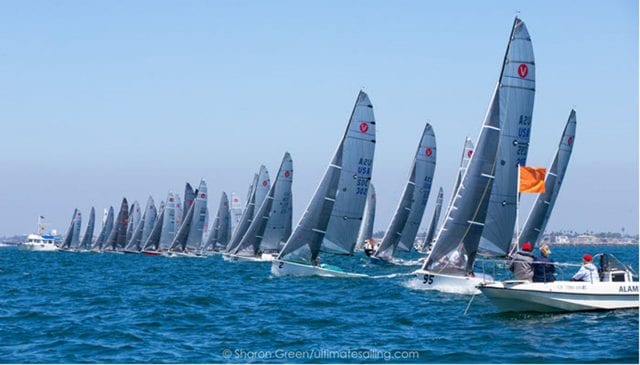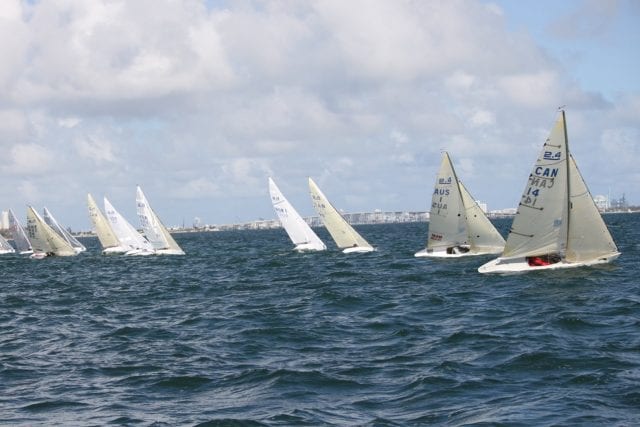By Nic Baird, professional sailor and coach

I’ve often heard people compare the decision-making aspect of sailing to that of a game of chess. In chess, players have to think several steps ahead to set up effective moves, and they have to consider what the opponent is likely to do in response. It’s true that sailors must also think several steps ahead and consider the competition, but this comparison leaves out a key difference between the two: uncertainty.
We’ve all been there, trying to make a call to go left or right without really knowing which is better. Or trying to tack to port and approach a starboard tacker, without being sure whether they will lee-bow or not. Sailing is full of uncertainties, and as a decision maker in one design classes, uncertainty can be a big hurdle to success. So how can we make more confident decisions in one design racing?
Think of sailing more like poker than chess. In poker, players bet on their odds of success with varying levels of uncertainty as the game progresses. If a player starts with pocket aces, they can be confident in their likelihood to win the hand, and they’re likely to bet more than a player who was has a weaker hand. Sailing is no different. We make bets on what is likely to happen in the future, and while bigger bets have high upside, they can also have significant downsides. If we think there’s a 100% chance that the right side of the course is better, then our race plan should have us as the furthest boat to the right side. If we think there is an 80% chance the right is better, but a 20% chance the left could come in, are we still going to be the furthest right boat…?
Make more confident decisions by matching your bet to your level of certainty.

By thinking of decisions in terms of their likelihood of success, we can easily compare the options that we have at any given moment. Here’s an example: It’s light air, and we know for certain that getting a start at the pin is strong. We also think the right side of the course is better, but we’re only marginally confident that is the case because there’s no significant difference in wind strength on either side. We know there’s a 100% chance that a pin start will gain us 5 boat lengths by the time the fleet gets to the top mark, and we know there’s a 75% chance that the right is better by 6 boat lengths. In this scenario, we can be 100% confident that a pin end start will get us to the top mark at best 5 boat lengths ahead, and at worst 1 boat length behind the leaders. Whereas with a boat end start going right we are 75% sure it will get us a 1 boat length lead over the pin start, but there’s a 25% chance we’re 5 boat lengths behind. By approaching the decision this way, the answer becomes very obvious. Over a ten or even five race event, choosing the pin end option will deliver better results.

We can use the same approach to better position ourselves relative to the fleet. Let’s say we’re covering a pack of ten boats upwind. Seven boats split to the right, and three split to the left. We have to decide which pack to go with and cover. On a steady day, the answer is obviously to go with the larger group of seven boats, but let’s approach this using our levels of confidence and make a bet. Take the same scenario, seven boats split right and three left, but this time we think there’s a 90% chance the next shift will come from the left. You can do a simple calculation to figure this out by multiplying the likelihood of a left shift by the number of boats going left, and the likelihood of a right shift by the number of boats going right. Whichever result is higher determines which direction, on average, will net a better result. 0.9*3 = 2.7; 0.1*7 = 0.7 ; in this scenario, you should go with the pack on the left. The same approach can be taken when behind the fleet and trying to gain boats. Let’s say I’m behind and want to bang a corner. I think it’s 20% likely this corner will gain me twenty boats. If I played up the middle, there’s a 100% chance that I could pick off five boats. Again: 0.2*20 = 4; 1*5 = 5 ; 5 is larger than 4, so I should go up the middle. Over a series of races, this approach will net better results. Sure, one time the 20% bet might work, but in a ten race series where each sailor is presented with a few dozen decisions like this, the one playing the odds is most likely to win.

This process of decision making can be applied to nearly every decision we make on the racecourse. What’s the risk if I try to cross that guy, how confident am I that I can cross? The pin is favored, how crowded will it be? How confident am I that I can have a good start at the pin? If I tack now how likely is that other boat to tack on me? What are the chances that I pass two boats by coming in late on port layline – what are the chances that I lose ten by fouling? By assessing what you believe to be the likelihood of potential outcomes, you can turn uncertain (low confidence) situations into confident ones. You’ll know the risk you’re taking and whether it’s worth it. You’ll be able to have confidence that by making the high percentage decision over and over again, you’ll be happy with the result by the end of the series of races.
So how do I get started thinking this way on the racecourse?
Ask yourself this question: “what if?” By asking yourself “what if x happens, or what if y happens,” you’ll get a better idea of the long-term consequences of each decision. Here’s an example: you’re thinking about tacking under a starboard tack boat. Seems like a strong move, you’ll be bow forward on them and likely pinch them off eventually. Before you tack, ask yourself, what happens if I tack there? That prompts you to look over your shoulder and realize there’s another port boat on your hip that’s likely to lee bow you if you tack. Then you’d be stuck between two boats with no way out and no lane. Maybe tacking under the starboard tack boat isn’t the best idea… Another example: the pin end is very favored, but the right side of the course is also stronger. Ask yourself, what if I start at the pin, and I can’t tack for a long time? The answer might be that it’s no big deal, because the line bias is enough to keep you ahead at the top mark, but the answer might be that the right side is so much better, that you’ll be below mid fleet if you can’t tack. Asking “what if” prompts us to think critically about the decision we’re about to make, and if it’s worth the risk or not.
Make Confident Decisions
Next time you go one design racing, try this approach to tactical decision making. You might find that it changes the way you see the racecourse. If so, that’s great! You might find that you have low levels of confidence for a majority of your decisions. That’s fine, too. If you use this approach to decision making, your confidence in your decisions will go up over time. Use the certainties as an anchor to compare uncertain situations to. As you gain more experience, you’ll notice more situations where a higher risk move worked more often than you thought it would. You can readjust your idea of how likely that move is to work the next time. Over time, the goal is to use the same approach, but improve your levels of confidence in the uncertain moments. You’ll better know when to deviate from the conservative, more guaranteed decisions, and take the riskier options when they’re likely to work out in your favor. Trust the process, and you will be happy with the outcome.
Nic Baird is a professional sailor and coach from St. Petersburg, Florida. He was the 2019 College Sailor of the Year, and now coaches the #1 ranked Stanford Sailing Team. As a professional, he sails many one-design classes, including the Etchells and the J70. Nic also works for the robotic mark company MarkSetBot. To contact Nic about coaching, sailing, or any general questions please email or call him at nebaird.sail@gmail.com | (727) 510-0162.
